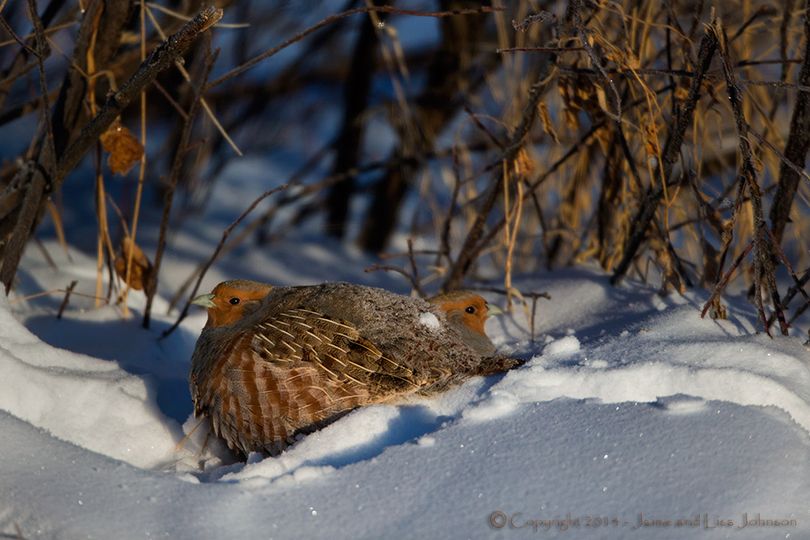Birds fluff up and take winter cold in stride

WILDLIFE WATCHING -- For being light a fragile, birds are incredible at surviving cold that drives humans indoors.
Birds are warm blooded, which means their bodies maintain a constant temperature, often around 106 degrees Fahrenheit. Since they can't just throw a log on the fire, birds have several ways of coping with bitter-cold temperatures.
Puff up: The Hungarian partridges featured above in an image by Montana outdoor photographer Jaimie Johnson have fluffed out their under-feathers to trap warm insulating air that acts like a thick down coat that can be quickly streamlined for flight if needed.
Take cover: Many birds also seek shelter from the elements, whether it's in thick brush or possibly -- as in the case of a nuthatch or chickadee, perhaps -- in the cavity of a tree or a bird box.
Huddle up: Some flocking birds will huddle, bunching together to share warmth, and try to minimize their total surface area by tucking in their head and feet and sticking up their feathers.
Fatten up: "Big birds, like geese and grouse, do what we do," says physiologist David Swanson at the University of South Dakota. "They put on insulation." Their insulation often involves growing an extra set of insulating downy feathers. Birds can also put on fat as both an insulator and energy source: More than 10 percent of winter body weight may be fat in certain species, including chickadees and finches. As a result, some birds spend the vast majority of their daylight hours seeking fatty food sources, making feeder food even more precious for surviving a frosty night.
Shake it: Small birds that can't clope with putting on extra weight simply shiver. Chickadees are masters at shivering -- but not the tremble that mammals use to generate heat. According to a story in Audubon Magazine, birds shiver by activating opposing muscle groups, creating muscle contractions without all of the jiggling typical when humans shiver. This form of shaking is better at retaining the bird's heat.
Down time: Some winter bird species undergo a more moderate version of the torpor hummingbirds use to survive through the night. Black-capped chickadees reduce their body temperature as much as 22 degrees Fahrenheit from their daytime level in a process called regulated hypothermia.
- Check out the Audubon Guide to Winter Bird-Feeding
